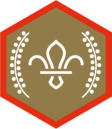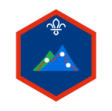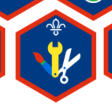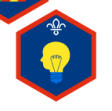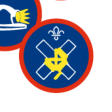


Who are Scouts?
Scouts are a proactive group of young people aged 10 ½ to 14 who master new skills, try new things, explore the world around them, have fun, go on adventures, and make a difference by helping others. They gather in groups called Scout Troops to conquer the small task of discovering the world on their terms and making the most of what they have. Alongside their new friends, they’ll try things they’d never get the chance to do at home or school, stand up for what they believe in and make a difference, confident in the knowledge that their daily actions add up.Joining Scouts
If you are ready to find out what Scouting is all about and are a Cub or new to Scouting, you can join the Scouts between the ages of 10½ and 14. To become a Scout, you need to earn your Membership Award - for this need to: • Get to know other members and Leaders in the Patrol and the Troop • Find out about the activities that the Patrol and Troop does • Find out about the ceremonies, traditions and rules in the Troop • Show that you know the general history and family of Scouts and Scouting around the world. • Learn and understand the Scout Promise and Law, the Scout Motto, sign, salute and handshake • Become a Scout by making the Promise when you are InvestedIf you are a Cub, you can start the Scout Membership
Award about three weeks before you are due to join the
Troop as part of your Cub Moving-on Award. You can
wear this on your Scout uniform and can transfer these
Cub Scout badges to your new Scout uniform:
• Joining In Badge (highest number) • Moving-On Award • Chief Scout’s Silver Award • Any Staged Activity Badges that you have (highest stage gained). Download information about ScoutsGetting Invested
Usually, you make your Promise in front of the other Scouts at an Investiture ceremony, your formal welcome to the Troop, and when you receive your Membership Award. You (and the Leaders!) are encouraged to apply the Promise to your daily lives. Your parents and family usually come to hear you make your Promise, as it is a momentous occasion not just for you as a new Scout but also for the whole Troop. If you don't already have one, you will also receive a lemon and red coloured scarf (sometimes called a 'necker') with the 'Isle of Wedmore' badge on it to show that you are part of Wedmore Group.Scout Promise & Law
As far as possible, it would be best if you tried to learn your Promise off-by-heart, as you should try your utmost to live by it. However, we understand that you may get nervous when speaking in front of the Troop, so you will usually repeat your Promise after a leader during your investiture. The Scout Promise is: ‘‘On my honour, I promise that I will do my best, to do my duty to God and to the King, to help other people and to keep the Scout Law.’’ There are alternative wordings of the Promise for members of faiths for whom the original wording is inappropriate. As part of your Promise, you also promise to keep the Scout Law, which is a series of positive statements of how you can live out your Promise - it is: • A Scout is to be trusted. • A Scout is loyal. • A Scout is friendly and considerate. • A Scout belongs to the worldwide family of Scouts. • A Scout has courage in all difficulties. • A Scout makes good use of time and is careful of possessions and property • A Scout has self-respect and respect for others. Download a Scout Promise sheetYour uniform
It would be best if you bought your uniform within the first few weeks of joining the Troop. However, it is worth waiting a couple of weeks to ensure that you settle in and that Scouting is for you. Meanwhile, Cubs should continue to wear their Cub Scout Uniform. It is important to remember that when a uniform is worn, it is an outward and visible sign, which should show Scouting at its best! The essential parts of the Scout uniform are • Group Scarf – The Group wears a lemon and red coloured scarf. Sometimes it is called a ‘necker’. It has the Wedmore Group badge on the back of it. The scarf is presented to you when you are invested in the Pack. Most Cubs like to wear their old scarf. • Woggle – This is usually a leather ring with the scout logo on it that holds the scarf in place. • Shirt – A long-sleeved, kingfisher green shirt, with an embroidered scout logo, onto which you can sew the badges you gain.. • Trousers – These are dark blue with a scout logo on them • Belt – This is leather with a metal buckle bearing the scout logoChallenges & badges
You can see how you are getting on in the Scouts, as there are several Challenge Awards to try to gain. You will do most of the things that you need to complete during your regular weekly meetings. There are also Activity Badges to test your skills and help you with new interests. These can also help you achieve some of your Challenge Awards and the Chief Scout's Award. Additionally, special staged badges cover a range of topics and skills you can tackle through your time in the Beavers Cubs and Scouts You can download an App for your mobile phone or note pad that gives you details of all the awards and badges you can gain, as wells as the promise and law - go to download nowChallenge Awards
There are nine Challenge Awards, which cover several themes, from the physical and ‘outdoorsy’ to challenges dealing with the local community or issues connected with the Scouting world. You need to show personal commitment and be fully involved in the activities. The level of involvement will depend on your previous experience and your ability. You can attempt a Challenge Award more than once; however, if you do, you will have to work harder at it the second time around. Clicking on the badges to the right will tell you what you need to do to meet the challenge. Click on any of the badges to go to the Scout Association website, which will tell you what you need to do to meet the challenge.Chief Scout's Gold Award
You should aim to get this badge, which is the highest award available in the Scouts. To gain it, you must have completed all of the above Challenge Awards, plus six activity or staged activity badges. If you have not entirely completed the requirements for this award when you move on to Explorer Scouts, you can complete it in your first term in the Explorer UnitActivity Badges
These cover a vast range of skills, experience, and interests and are designed to be achieved by you at home or through a hobby you have, or you may want to try on something that is of particular interest to you. You may need additional help to understand what you need to do for some of the badges. Always talk to a Scout Leader about the badge you want to do or which you think that you have achieved. Click here to go to the Scout Association website, where you will find a list of all of the Scout Activity Badges and details of what to do to achieve them.Staged Badges
These badges have several stages, which get more difficult as they go on - they are to help you develop your special interests and help complete your Challenge and Chief Scout's Awards. They can be done in any order and cover a range of topics and skills; you can begin at whatever stage you find to be the hardest. However, the stages do get more difficult each timeJoining-in Awards
These numbered badges show how many years you have been in the Scout Movement, starting from the time you first joined. You can wear all of the badges you get while in the Cubs, then keep the highest numbered badge when you move on to Explorer Scouts.Moving-on Award
The Scout Moving-on Award helps you to make a smooth transfer to become a Young Leader or an Explorer Scout. Around-about your 14th birthday, the District Commissioner responsible for the Young Leader and Explorer Scout Units will contact you to ensure that your move to this section is as smooth as possible. Have a look at the Young Leader and Explorer Scout sections of this website to find out about this section of Scouting. During this period, you will be able to take part in both Scouts and Explorers for a short time (at least three weeks) and take an active role in the Young Leader or Explorer Unit programme. At the end of this time, your Scout Moving-on Award will be presented to you, which you can wear on your Explorer Scout shirt. There are loads of great reasons to become a Young Leader linked to Wedmore Group, including the opportunity to develop your leadership skills and the chance to have fun teaching and be with young people within the Beavers, Cubs, and Scouts in Wedmore.How Scouts started
Robert Baden-Powell (or B-P for short) started Scouting. As a boy, B-P enjoyed the outdoors and spent many hours pretending to be a hunter or an Indian scout. He also went on expeditions with his brothers in the countryside, carrying everything they needed on their backs. When B-P left school, he joined the British Army. While he was serving in South Africa, B-P led the defence of a small town called Mafeking for seven months against the Boers, who outnumbered his men nine to one. As there were so few soldiers, he asked local boys to be messengers. On returning to Britain, B-P saw that, apart from sport, young people in Britain had very little to do. He remembered what he had learnt in Africa and decided to teach the boys in Britain those skills. To test his new methods, B-P organised a camp for 20 boys on Brownsea Island, Dorset, during the summer of 1907. Over a week, B-P taught the boys exploring, camping, boating, lifesaving and lots more activities, all of which Scouts still do today. After the camp, B-P wrote a book based on his experiences, called ‘Scouting for Boys’, published in 1908 in six fortnightly parts at fourpence a copy. Thousands of boys bought the book and formed themselves into Patrols, taking part in the activities they read. The Patrols asked adults to become their Leaders, and so the Patrols formed into Troops. What was intended to be used as a training aid for existing organisations became the handbook of a new Movement, which secured the royal seal of approval in 1909 when King Edward VII agreed to introduce the King’s Scout Award. In its first census in 1910, Scouting had almost 108,000 members, of which over 100,000 were young people. In 1920, the first World Scout Jamboree was held in London, where Scouts from all over the world camped together. The Scouts came from many different countries and camped for eight nights. At this Jamboree, B-P was declared the first and only Chief Scout of the World. Scouting spread quickly worldwide, and there are now over 28 million Scouts in more than 200 countries. In 2007, the Movement celebrated its centenary, and the 21st World Scout Jamboree was held in the UK. Click here to find out about the history of Wedmore Scout Group Click here to find more information about World Scout Jamborees






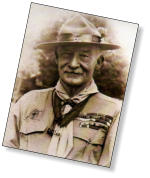
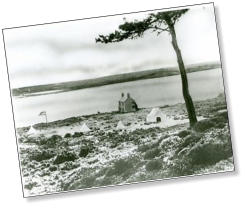





What do you
want to look at?
•
Join in
•
Beavers
•
Cubs
•
Scouts
•
Explorers
•
Adults
•
Group
•
Links
•
Diary
What do you
want to check?
Joining
Investiture
Promise & Law
Your uniform
Badges to get
How it started
Scout meetings
Monday evening
7.15 to 8.45 pm



































